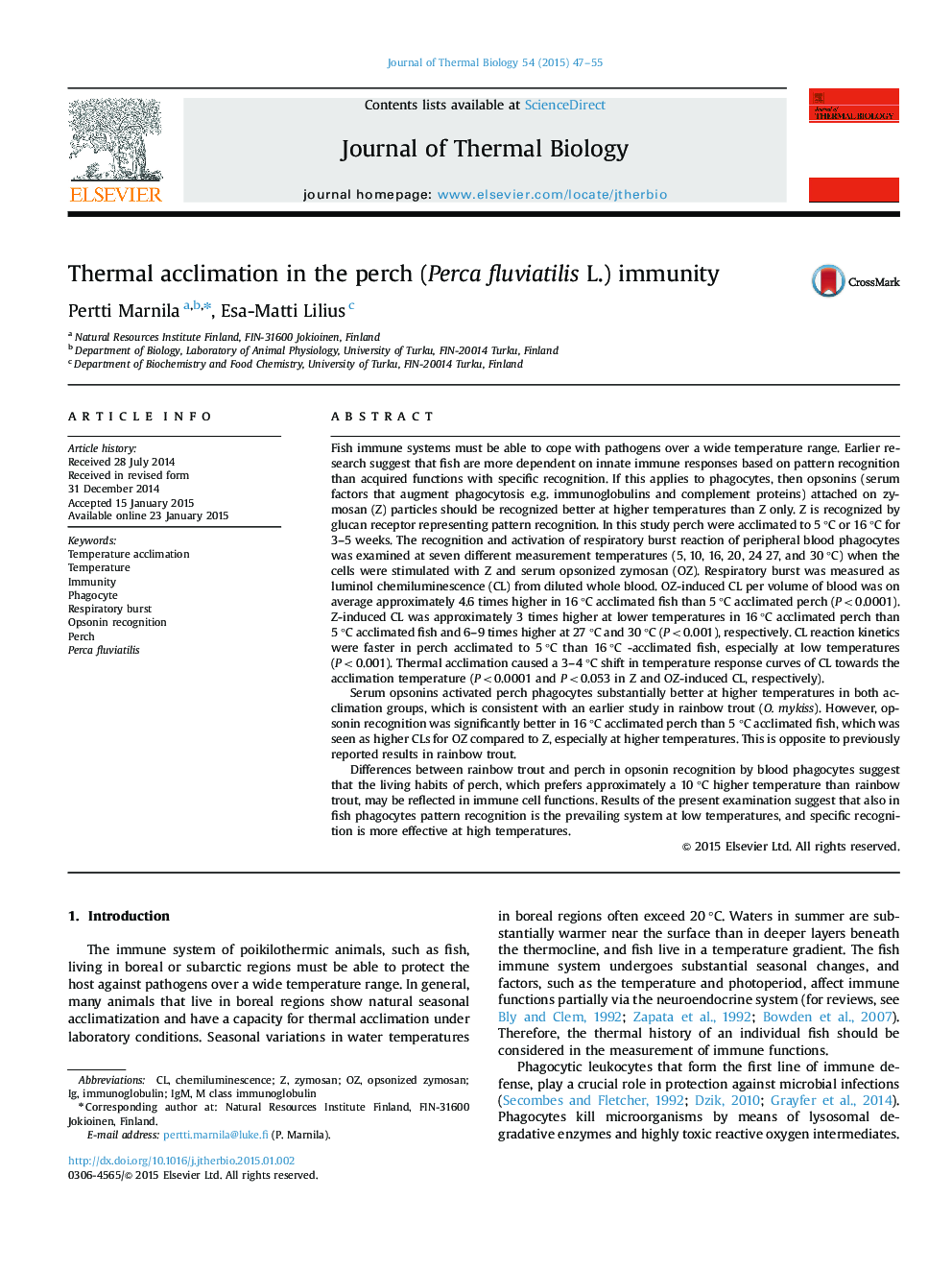| کد مقاله | کد نشریه | سال انتشار | مقاله انگلیسی | نسخه تمام متن |
|---|---|---|---|---|
| 2842704 | 1571092 | 2015 | 9 صفحه PDF | دانلود رایگان |

• The first study on perch (Perca fluviatilis) phagocyte functions.
• Serum opsonin recognition depend on temperature and is better at warm than at cold.
• Acclimation to warm improve opsonin recognition which is opposite than in earlier study in rainbow trout.
• Perch prefer approximately 10 °C higher temperature than rainbow trout. This is in seen phagocyte functions.
• Support hypotheses that at cold innate immunity prevail more than acquired immune functions.
Fish immune systems must be able to cope with pathogens over a wide temperature range. Earlier research suggest that fish are more dependent on innate immune responses based on pattern recognition than acquired functions with specific recognition. If this applies to phagocytes, then opsonins (serum factors that augment phagocytosis e.g. immunoglobulins and complement proteins) attached on zymosan (Z) particles should be recognized better at higher temperatures than Z only. Z is recognized by glucan receptor representing pattern recognition. In this study perch were acclimated to 5 °C or 16 °C for 3–5 weeks. The recognition and activation of respiratory burst reaction of peripheral blood phagocytes was examined at seven different measurement temperatures (5, 10, 16, 20, 24 27, and 30 °C) when the cells were stimulated with Z and serum opsonized zymosan (OZ). Respiratory burst was measured as luminol chemiluminescence (CL) from diluted whole blood. OZ-induced CL per volume of blood was on average approximately 4.6 times higher in 16 °C acclimated fish than 5 °C acclimated perch (P<0.0001). Z-induced CL was approximately 3 times higher at lower temperatures in 16 °C acclimated perch than 5 °C acclimated fish and 6–9 times higher at 27 °C and 30 °C (P<0.001), respectively. CL reaction kinetics were faster in perch acclimated to 5 °C than 16 °C -acclimated fish, especially at low temperatures (P<0.001). Thermal acclimation caused a 3–4 °C shift in temperature response curves of CL towards the acclimation temperature (P<0.0001 and P<0.053 in Z and OZ-induced CL, respectively).Serum opsonins activated perch phagocytes substantially better at higher temperatures in both acclimation groups, which is consistent with an earlier study in rainbow trout (O. mykiss). However, opsonin recognition was significantly better in 16 °C acclimated perch than 5 °C acclimated fish, which was seen as higher CLs for OZ compared to Z, especially at higher temperatures. This is opposite to previously reported results in rainbow trout.Differences between rainbow trout and perch in opsonin recognition by blood phagocytes suggest that the living habits of perch, which prefers approximately a 10 °C higher temperature than rainbow trout, may be reflected in immune cell functions. Results of the present examination suggest that also in fish phagocytes pattern recognition is the prevailing system at low temperatures, and specific recognition is more effective at high temperatures.
Journal: Journal of Thermal Biology - Volume 54, December 2015, Pages 47–55